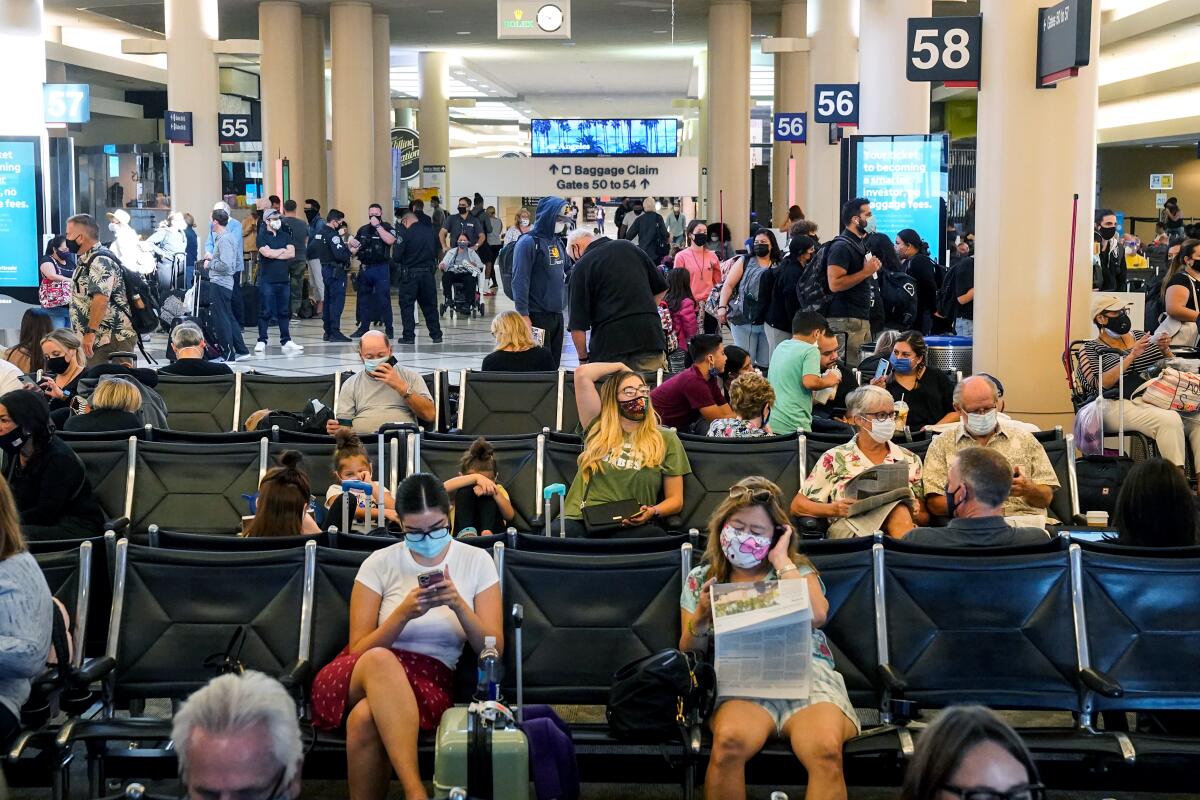Get ready for another roaring ’20s, UCLA economic forecast predicts

- Share via
You may be shut inside your home. You may be out working a job but in fear of contracting the coronavirus. You may be mourning the demise of your neighborhood’s small businesses. You may be unemployed and unable to pay your rent.
And for the next few months, the situation may grow even worse.
But then get ready for the roaring ’20s.
UCLA economists issued an optimistic forecast Wednesday, predicting the U.S. economy will experience “a gloomy COVID winter and an exuberant vaccine spring,” followed by robust growth for some years.
“The ’20s will be roaring, but with several months of hardship first,” according to the quarterly UCLA Anderson forecast. “These next few months will be dire, with rising COVID infections, continued social distancing, and the expiration of social assistance programs.”
The forecast, which assumes mass vaccination of Americans will take place by summer, predicts that annualized growth in the nation’s gross domestic product will accelerate from a weak 1.2% in the current quarter to 1.8% in the first quarter of next year, then to a booming 6% in next year’s second quarter and consistent 3% growth each quarter thereafter into 2023.
“With a vaccine and the release of pent-up demand, the next few years will be roaring as the economy accelerates and returns to previous growth trends,” wrote Leo Feler, a senior economist with the forecast. “We expect a surge in services consumption and continued strength in housing markets to propel the economy forward.”
California’s recovery will ultimately look similar to the U.S. trajectory, the forecast predicts. In October, the state’s unemployment rate was 9.3%, considerably higher than the national rate of 6.9%, and probably influenced by a loss of international tourism and tighter restrictions on businesses than in many other parts of the country.
But “the state is due to grow faster than the U.S. once restrictions are lifted and the pandemic is in the rearview mirror,” wrote economists Jerry Nickelsburg and Leila Bengali, authors of the California section of the report.
California joblessness will drop from 8.9% in the last quarter of this year to 6.9% in 2021, 5.2% in 2022 and 4.4% in 2023, according to the forecast. That’s still higher than the pre-pandemic rate of 3.9% in February.
The lucky among California’s small businesses have cobbled together loans and grants to get through the pandemic so far. But that money has dried up, and “you can only take on so much debt.”
Nonfarm payrolls will drop 6.8% this year and then — boosted by technology, residential construction and logistics jobs — will grow 3.6% next year, 3.8% in 2022 and 2.5% in 2023, the forecast predicts.
But the tourist-dependent leisure and hospitality sector, which bore the brunt of California’s 1.37-million-job loss over the last year, could remain 20% below its January 2020 peak even by the end of 2023, according to the forecast, as travelers remain concerned about safety and consumers feel pinched by the income lost during the pandemic.
“That translates to 200,000 relatively low-income Californians with long-term unemployment for 30 months following the end of the pandemic,” Nickelsburg and Bengali wrote.
Meanwhile, the report says, national “headline numbers don’t capture the economic misery that so many are experiencing. Currently, 20.5 million Americans are receiving some form of unemployment insurance benefit. Nearly 9% of Americans live in households that are not current on rent or mortgage, 12% live in households where there was either sometimes or often not enough food to eat, and about one-third live in households where it has been somewhat or very difficult to pay for usual household expenses during the pandemic.”
The pandemic has contributed to inequality, Feler wrote. “For those fortunate to maintain employment and income during this pandemic, their financial situation is better than before. Home values have increased, equity values have increased, and limited consumption opportunities during the past nine months mean that these households have been able to accumulate at least an additional $1.6 trillion in savings.”
UCLA economists’ assumption of mass vaccination by mid-2021 conforms with the expectations of many health experts. But health experts caution that it is too soon to be sure sufficient doses will be available, enough people will take them to achieve herd immunity, or that they’ll offer enough protection to let life return to the way it was before the pandemic.
Officials caution that face masks, physical distancing and other restrictions will need to remain in place for some time even after vaccines are rolled out. Meanwhile, the virus is rapidly spreading.
In the week that ended Tuesday, California averaged 22,220 new coronavirus cases a day — up 78% from two weeks earlier, according to The Times’ tally of infections. On Monday, as the effect of a “Thanksgiving bump” took hold, a record 34,490 new cases were reported. State and local officials, fearing that hospital intensive care units will soon be overwhelmed, have ratcheted up restrictions on businesses.
Businesses fear they’ll be blamed for COVID-19’s spread. They’re fighting for measures to protect them from lawsuits over infections, hospitalizations and deaths.
On the economic front, it remains uncertain whether Congress will soon approve a stimulus package large enough to revive a wounded labor market, sustain devastated small businesses and buoy state and local governments. Without additional fiscal relief, the economy may stay in recession next quarter, Feler suggested.
Even if federal relief comes through, economists are divided on how fast the overall economy can bounce back.
UCLA forecasters “make some pretty strong assumptions around the vaccine,” said Scott Anderson, chief economist at Bank of the West in San Francisco. “Everything has to go right with production, distribution and consumer demand to get the vast majority of the population vaccinated in the second quarter of next year. Even by the third quarter is somewhat optimistic.”
Anderson sees as “unlikely” UCLA’s expectation of 1.8% GDP growth in the first quarter of next year and 6% in the second quarter. His calculations: 1.3% and 2.6%, respectively. “The hangover from business shutdowns and layoffs will hit household spending the hardest after the holidays,” he said.
Anderson agreed that “tech, residential construction, and logistics will drive faster California growth, but I’m not as confident those ebullient trends will continue beyond the initial pent-up demand. California leisure and hospitality, tourism and international-trade-focused industries will continue to struggle.”
Based on a lack of supply, low mortgage rates and high demand among millennials, Nickelsburg and Bengali predicted a “relatively rapid return of home building” in California with 123,000 new units next year, a 16.2% jump over 2020, and gradual growth to 132,000 in 2023. However, they wrote, that’s far fewer units than would be needed to fix the state’s housing affordability problem just by building.
That dearth of affordable housing “along with wildfires, power shutoffs and the working-from-home trend could push more folks to move out of the state even if their employers remain,” Anderson suggested.
Even if the state builds more homes, commercial construction is unlikely to revive soon, according to the UCLA forecast.
“If the higher rates of working-from-home and online shopping persist to a moderate extent after the pandemic is over, we’ll be over-supplied on office and retail space,” Feler wrote.
“There will be little demand for additional commercial investment, at least in urban cores. State and local construction is likely to take a hit as state and local governments reduce infrastructure budgets in response to lower tax revenues and the need to replenish rainy-day funds.”
Even after a vaccine takes hold, the UCLA forecast predicts, “for better and worse, some parts of the economy will never be the same.”
On the upside: The pandemic has speeded up adoption of online courses and telehealth, making education and healthcare more accessible. The downside: “It has permanently eliminated many service and retail sector jobs and made the economy more unequal.”
More to Read
Inside the business of entertainment
The Wide Shot brings you news, analysis and insights on everything from streaming wars to production — and what it all means for the future.
You may occasionally receive promotional content from the Los Angeles Times.













